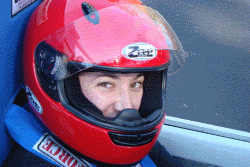Post by fastfotos on Nov 23, 2006 22:45:14 GMT -5
How to Capture Great AutoX Pics
After shooting a few of the AutoX events over the past season, I thought I'd share my thoughts with you all about how you too can achieve great results with your camera. I see alot of people out there alongside of me with their cameras, so I going to put some tips down for you for next season.
First of all, I shoot with a Digital SLR, but theses same techniques can be applied to film SLR's and Point and Shoot style cameras with manual controls.
Generally, the lowest ISO setting will be best, since you're not going to be trying to stop a whole lot of motion to begin with. ISO 100 or 200 is usually sufficient. The higher the ISO, the nosier, or grainier the image will be...that detracts from the overall image quality.
To impart a sense of motion to the cars, you will use a technique called Panning. Essentially, as the subject becomes parrallel to the film/sensor plane, you will open the shutter and move in sync with the subject until the shutter closes. I have found that shutter speeds of 1/125 - 1/80 are sufficient. When the camera is in shutter priority mode, when you set the shutter speed, the camera will select an appropriate aperture to achieve the best exposure. Panning takes practice. The longer the shutter is open, the blurrier the background and the more motion is imparted on the overall picture. If you stayed up to speed wih the subject, then it wil be sharp.
Occasionally the cameras exposure meter wil be tricked by shiny cars and bright windshields on sunny days....realy nothing to do here except use exposure compensation. Overexpose for white, underexpose for dark/black cars.
I have found that real long lenses aren't that necessary either. Depending on the venue, focal lengths less than 125m are fine, depending on where you stand. You can get away with fairly slow lenses as well. If it is really bright, and you want longer shutter speeds, you can add a polarizer to cut some of the light. These also help to remove unwanted reflections from paintjobs and glass.
For doing the really long shutter speeds, a monopod is helpful. Cheap monopods can be had for about $24. Not only will they help support the camera, but they make panning much easier, since it easier to keep the camerea rotating on one plane.
I hope that some of you wil use some of these tips to your advantage. If you have any questions, please ask.
Josh

After shooting a few of the AutoX events over the past season, I thought I'd share my thoughts with you all about how you too can achieve great results with your camera. I see alot of people out there alongside of me with their cameras, so I going to put some tips down for you for next season.
First of all, I shoot with a Digital SLR, but theses same techniques can be applied to film SLR's and Point and Shoot style cameras with manual controls.
Generally, the lowest ISO setting will be best, since you're not going to be trying to stop a whole lot of motion to begin with. ISO 100 or 200 is usually sufficient. The higher the ISO, the nosier, or grainier the image will be...that detracts from the overall image quality.
To impart a sense of motion to the cars, you will use a technique called Panning. Essentially, as the subject becomes parrallel to the film/sensor plane, you will open the shutter and move in sync with the subject until the shutter closes. I have found that shutter speeds of 1/125 - 1/80 are sufficient. When the camera is in shutter priority mode, when you set the shutter speed, the camera will select an appropriate aperture to achieve the best exposure. Panning takes practice. The longer the shutter is open, the blurrier the background and the more motion is imparted on the overall picture. If you stayed up to speed wih the subject, then it wil be sharp.
Occasionally the cameras exposure meter wil be tricked by shiny cars and bright windshields on sunny days....realy nothing to do here except use exposure compensation. Overexpose for white, underexpose for dark/black cars.
I have found that real long lenses aren't that necessary either. Depending on the venue, focal lengths less than 125m are fine, depending on where you stand. You can get away with fairly slow lenses as well. If it is really bright, and you want longer shutter speeds, you can add a polarizer to cut some of the light. These also help to remove unwanted reflections from paintjobs and glass.
For doing the really long shutter speeds, a monopod is helpful. Cheap monopods can be had for about $24. Not only will they help support the camera, but they make panning much easier, since it easier to keep the camerea rotating on one plane.
I hope that some of you wil use some of these tips to your advantage. If you have any questions, please ask.
Josh



